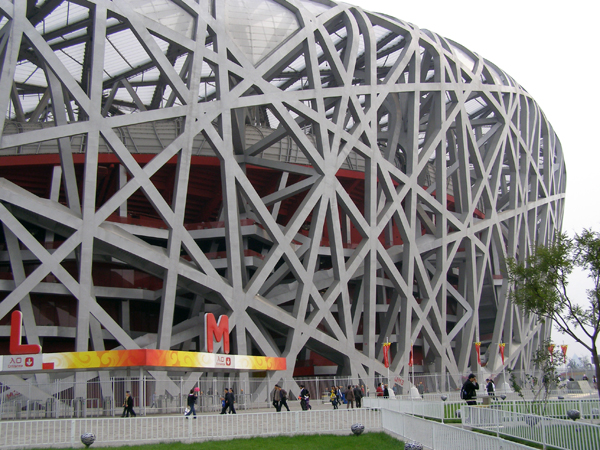
A few months ago I read a piece from Bloomberg discussing Frank Gehry’s decision to ‘turn to Asia for architecture projects as U.S. growth slows.’ In terms of big name architects from the U.S. and Europe turning to Asia for work, Gehry is late to the party. Nevertheless, it is a very telling sign that Gehry, someone who in the past could be highly selective of his clients, is looking to Asia to keep his office busy.
In the Bloomberg article, Gehry is candid about his desire to work domestically in the U.S. yet lacking the opportunity due to the depressed economic situation. As if another reminder is needed about the sorry state of the industry, Salon published a piece about the dire outlook for the profession last month titled ‘The Architecture Meltdown‘.
So aside from returning to graduate school, designing furniture or leaving the profession completely, most architects in the U.S. and other Western nations have limited options, therefore turning to emerging markets where there is work happening. China is by far the largest of these emerging markets for new buildings.
As such, over the past year I have received many inquiries asking for advice about doing business in the architecture/construction/real estate industries in China. There is never one ‘magic-bullet’ to successfully pursuing architecture work in China as different types of architects have different specialties and varying range of resources. Most of the very large, international corporate firms already have a foothold into the market, and with their wider resources, many have already established locally staffed offices in Beijing and Shanghai.
One of the greatest misconceptions about doing work in China is that it is one great big tabula rasa for trying out wild new architectural ideas. Surely this is the case for a select few, but if your name is not Zaha Hadid, Steven Holl or Rem Koolhaas, you can forget about China being an ideal playground for realizing this kind of fantasy.
The reality is much more stark and the competition for work increasingly fierce. The competition these days is not only between foreign architects operating in China, but also with domestic Chinese architects who are quickly learning and moving up the value chain in terms of design ability.
With that said, China remains a bright spot in the global economy for urban growth and there is still ample opportunity for the courageous and ambitious. Below is a list of ten recommendations to architects looking to do work in China:
(Special thanks to Matthias Bauer, Studio Leader of Urban Design at Atkins Beijing for his insight and contribution to this list)
1. Make sure that your client is able and willing to pay for your work. Insist on being paid up-front, if possible, and never agree to do any unpaid work.
Too many architects jump into the China market only to quickly find themselves caught up in situations where they are not appropriately compensated for their work. Given the current lack of new work in the developed world, property developers in China know that they have the upper hand when it comes to soliciting services from experienced Western architects and will use this fact to undercut design fees.
2. Many projects may have, at least initially, more to do with ‘market research’, ‘branding’, ‘image’ or ‘positioning’ and not actual design. Your work, especially at the beginning stages, should reflect this.
In addition, don’t expect your client to explicitly tell you what the design is for. What they might not tell you is that there is already a design from a local ‘design institute’ (LDI) planned for construction, but need you to provide something with more of a ‘wow’ factor to satiate government officials. Another reason might be that a developer is trying to win a land bid and wants to show that they can build something cutting-edge to gain an advantage.
3. The Western idea of progressing projects step-by-step, proceeding from the abstract and general to the detailed solution, is on the whole alien to China. Expect to be asked to do everything at once, right now.
Chinese clients like to feel like they are getting their money’s worth and expect the architect to prove it through volume of work produced. Powerpoint presentations with less than 100 slides are not taken seriously and are merely taken as evidence that you haven’t worked hard enough. Even if your design will never be built, you are nonetheless expected to deliver detailed designs right from the start.
4. Don’t expect the project to proceed at lightning speed. Instead, it will be more of a stop-and-go process, as the client will often need some time for internal discussions or for negotiations with the government, during which the project will grind to a halt, sometimes for months.
Planning bureaucracy exists in China just as it does in the West, just in different form. In the West, the transparent nature of the planning process ensures that stakeholders have a clear idea of the various issues to be worked out. In China, the big decisions happen behind closed doors. So expect to modify, adjust or completely change your design over and over without clear explanations as to the reasons why. Moreover, expect this to happen with very short notice and to short deadlines.
5. Understand that the initial schedule agreed with your client is for guidance only. Any deadlines, meeting times, presentation times, etc. will change often at short notice.
This relates to #3 in that clients expect you to cater to their whims, regardless if you have other things scheduled for your day. There were several instances in one of the firms I worked where clients showed up at the office unannounced expecting to hold impromptu meetings. Be aware that Chinese developers like to keep their architects on their toes.
6. Meetings and presentations to high-level government leaders (such as Mayors or Vice Mayors) or real estate executives never take place at the agreed time.
At the day of the presentation, expect the time to be changed frequently every half an hour or so until the meeting is cancelled altogether and then re-scheduled again for the same day, late at night. Also be prepared to be contacted on Sunday night and asked to give a presentation for a new design option Monday morning.
7. Use flashy 3D renderings and multimedia animations to sell your design. Try to show reasonably detailed master plans, detailed architectural design and detailed landscape design right from the start, as nobody will understand simple massing models or abstract diagrams.
Most of the time, Chinese developers and government officials lack the capacity to understand the artsy and abstract presentation drawings coveted by the architecture community. Rather, drawings should be as easily comprehensible and computer renderings should show substantial Photoshopped entourage complete with crowds of people, detailed landscaping, luxury cars, abundant storefront signage, and even fireworks, hot air balloons and blimps in the sky.
8. Don’t assume that as a Westerner you could somehow override and ignore Chinese planning law, Chinese building regulations or any unwritten Chinese rules and standards, even if they seem entirely unreasonable to you.
Your job as a foreign architect in China is to add prestige to a development and maybe a bit of experienced design insight. Don’t let this give you the impression that you have license to single-handedly change local planning laws.
9. Understand that the Chinese are generally not interested in their own architectural legacy. Trying to preserve existing old buildings will be an arduous and mostly futile undertaking.
Likewise, offering contemporary versions of ancient Chinese courtyard houses and hutongs, as so many newcomers to China attempt to do, will likely not get you anywhere. Western architects are hired to bring their expertise from the West to China, not to reinterpret Chinese history (although I must admit as a designer looking for inspiration, it is always tempting to dig through the treasure trove of Chinese history to arrive at an architectural concept even if there is a high probability that the idea will be rejected).
10. Understand that in China, as presumably in your home country, master planning and architecture serve a professional, hard-nosed and profit-seeking real estate industry. In the end, it always comes down to money.
If you pursue design as a form of self-expression, China is likely to deeply disappoint you. If you look at China as a business opportunity and chance to expand your international design portfolio, venturing into the Middle Kingdom can be an exciting and highly rewarding adventure.


by Adam Mayer
Hao Hao Report - Someone thinks this story is fantastic…
This story was submitted to Hao Hao Report – a collection of China’s best stories and blog posts. If you like this story, be sure to go vote for it….
Nick - great insight at working in China, I would add #11 acquiring a taste for baijiu ??
Adam Nathaniel Mayer - Haha! Absolutely!
George - Late to the party is a great way to put it. Nicely done.
George
Jimbo - 100% correct!!! Everything is true here!
And I hate it…
J.P. Katigbak - Everything is too good to be true, isn’t it?
Well, be warned: this article doesn’t do justice to the historical and present realities in China regarding architectural styles and planning methods. Does it have proof, really? Please give an appropriate answer and send it to me personally.
Thank you very much.
-J.P.K.
Adam Nathaniel Mayer - J.P.K.,
Can you please clarify what you mean by “does it have proof”? This article wasn’t meant as a deep analysis of historical architectural styles and planning methods in China, but rather a no-nonsense guide for foreign architects working in the country today.
Like any great civilization, China has an interesting architectural history, but it is pretty much irrelevant to the fast paced nature of urban development happening at the moment.